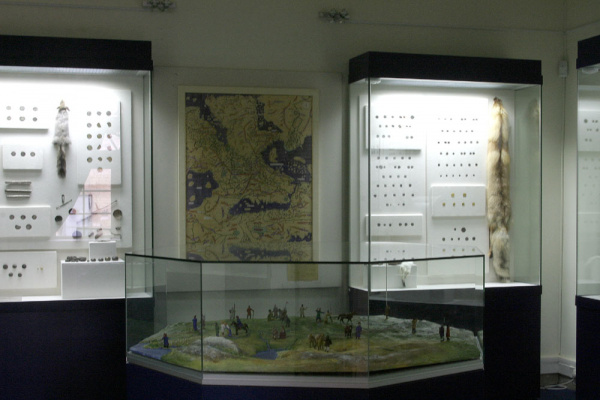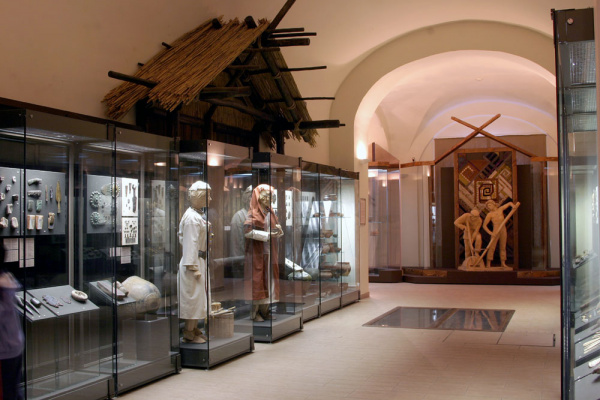Museums have a definite place among social and cultural institutions of today’s society and occupy one of the most fundamental places, preserving valuable retrospective information.
According to experts, museums in Russia emerged in the XIX century. In the first half of the XIX century a number of new museums of historical type opened and became available in the territory of the Russian Empire. At the same time, it is noteworthy that, for instance, in the XIV-XV centuries the Moscow Kremlin became the main treasury. It was based on symbols of power: the Cap of Monomakh, the orb, the scepter, expensive weapons, gifts, etc. The collected items were to stun subjects and foreign ambassadors. The inspection of these things became a ritual of the Moscow court. Special rooms were built for the treasury, and evacuation of the most valuable items was envisaged. Thus, in 1572 during the Tatar raid, things were taken to Novgorod in 450 sledges. In 1605-1612 the Moscow Kremlin and its treasury were plundered by the Poles, but later restored by the Romanovs.
The concept of a museum in the XIX century reflected the dominant ideas of enlightenment, social transformation through art and moral development of the individual.

The museum premises were separated from the palace premises; the function of collecting was changed from a collection of rarities to a systematized collection of monuments accessible to a wider public. In 1852, the construction of the New Hermitage (designed by Leo Klenz) was completed. It was part of a palace complex and was conceived as Russia’s first publicly accessible historical and art museum. The building was constructed for museum purposes – it was provided for in the layout of the halls and galleries for the accommodation of the collections, restoration workshops and orders for equipment (special showcases, slides and cupboards for storing and displaying items). Great attention was paid to the lighting of the halls.
Since the 1970s, Russia experienced a kind of museum boom. In many provincial and district towns museums were opened, accessible to all segments of the population and taking on educational functions. Zemstvo (institutions of local government), universities and scientific communities played a major role in their creation.
The Historical Museum, designed by V.O. Sherwood and A.A. Semyonov, was opened in 1883. The exterior appearance of the building, on the one hand, is typical of the prevailing eclectic style and appeals to the forms and decorations of the Old Russian architecture. On the other hand, it is determined by the position of the museum on the Red Square in immediate proximity to the Kremlin and the Intercession Cathedral. The complex composition of the building, which is a square with four towers divided by three inner courtyards, is reflected in the internal space planning.
One of the oldest museums in Russia was founded as the Kazan City Museum of Science and Industry in 1894. The grand opening of the museum took place on 5 April 1895. At present, the National Museum of the Republic of Tatarstan is a leading scientific and methodological centre and project office for the museum industry in the region and one of the largest regional museums in Russia. The museum collection of the National Museum of the Republic of Tatarstan consists of over 940 thousand items – monuments of material and spiritual culture, many of which are true treasures.
The museum actively cooperates with leading scientific institutions both in Russia and abroad. The museum has a Scientific Council with its own sections, Scientific Methodological and Exposition Councils. The museum conducts scientific research and organizes international and all-Russian scientific and practical conferences, seminars and trainings.
Much attention is paid to creating brand new museum products that combine modern technologies and traditional forms of working with visitors: there are not only guided tours and fund shows, but also large-scale events, festivals, quest games and flesh mobs; new exhibitions presenting extensive collections are being opened, catalogues and booklets are being published, etc.

The National Museum of the Republic of Tatarstan is active within museum communities - ICOM Russia, Union of Museums of Russia, Association of Ethnographic Museums of Russia, Assembly of Petrovsky Museums of Russia, Association of Literary Museums of Russia, etc.
The National Museum of the Republic of Tatarstan includes 13 branch museums: the A.M. Gorky and F.I. Chaliapin Museum, the Tukai Literature Museum, the Museum of Tatar Literature with a memorial flat of Sh. Kamal, the E.A. Boratynsky Museum, the Great Patriotic War Memorial Museum of 1941-1945, the Lenin House Museum, the M. Jalil Museum Apartment, the Y. Kupala Museum in the village of Pechischi and the A.M. Gorky Museum in the village of Krasnovidovo, the S. Saydashev Museum, the K. Nasyri Museum, the N.G. Zhiganov Museum, and the Lenino-Kokushkino State Museum-Reserve.
Author: Executive Director of the Foundation for Strategic Dialogue and Partnership, Doctor of Political Science - Elmira Lenarovna Sadykova
